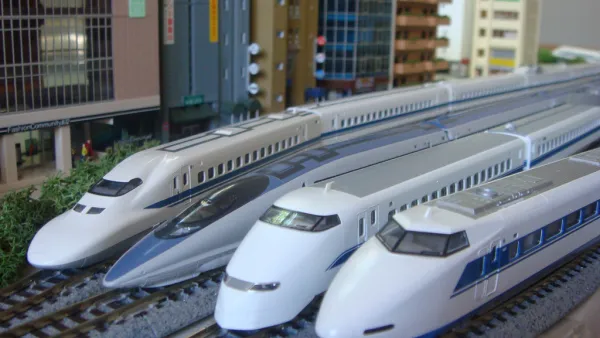The line may only be 12 miles, but the train speeds at 312 mph. The Secretary of Transportation was in Japan as part of the effort to bring high speed rail to the U.S. though it's not clear whether he is in fact considering the maglev technology.
Japan is anxious to find customers for its fast trains, particular maglev, the fastest type of train. The world's first high speed rail is The Shinkansen that opened in 1964, also in Japan - but some in the U.S. feel that the latest technology should be considered for U.S. HSR corridors.
"Very fast," Mr. LaHood said after stepping off the maglev at a track nestled here in mountains west of Tokyo. "We're right at the start of an opportunity for America to be connected with high-speed, intercity rail," he said.
"Maglev, short for "magnetic levitation," uses powerful magnets that allow the train to float just above the track, reducing friction. The train starts off on wheels, then gravitates upward after reaching high speeds
Japan has also been goaded into a new export boldness by the rise of China, a rival whose surge in construction of high-speed rail networks could give Beijing an economies-of-scale edge in the global railway market.
Central Japan Railway, which is based in Nagoya and is more commonly known as JR Central, is promoting its N700-I trains, which are in use in Japan and can run at a top speed of about 330 kilometers (205 miles) an hour. If Japan does not start selling maglev trains overseas, it risks losing its technological edge, Hitoshi Ieda, a professor in civil engineering at the University of Tokyo, warned. Unless JR Central can win a contract, the maglev, for now, could stay nothing more than a novelty."
Thanks to Mark Boshnack
FULL STORY: Japan Starts to Shop Its Bullet Train Technology

National Parks Layoffs Will Cause Communities to Lose Billions
Thousands of essential park workers were laid off this week, just before the busy spring break season.

Retro-silient?: America’s First “Eco-burb,” The Woodlands Turns 50
A master-planned community north of Houston offers lessons on green infrastructure and resilient design, but falls short of its founder’s lofty affordability and walkability goals.

Delivering for America Plan Will Downgrade Mail Service in at Least 49.5 Percent of Zip Codes
Republican and Democrat lawmakers criticize the plan for its disproportionate negative impact on rural communities.

Test News Post 1
This is a summary

Test News Headline 46
Test for the image on the front page.

Balancing Bombs and Butterflies: How the National Guard Protects a Rare Species
The National Guard at Fort Indiantown Gap uses GIS technology and land management strategies to balance military training with conservation efforts, ensuring the survival of the rare eastern regal fritillary butterfly.
Urban Design for Planners 1: Software Tools
This six-course series explores essential urban design concepts using open source software and equips planners with the tools they need to participate fully in the urban design process.
Planning for Universal Design
Learn the tools for implementing Universal Design in planning regulations.
EMC Planning Group, Inc.
Planetizen
Planetizen
Mpact (formerly Rail~Volution)
Great Falls Development Authority, Inc.
HUDs Office of Policy Development and Research
NYU Wagner Graduate School of Public Service




























